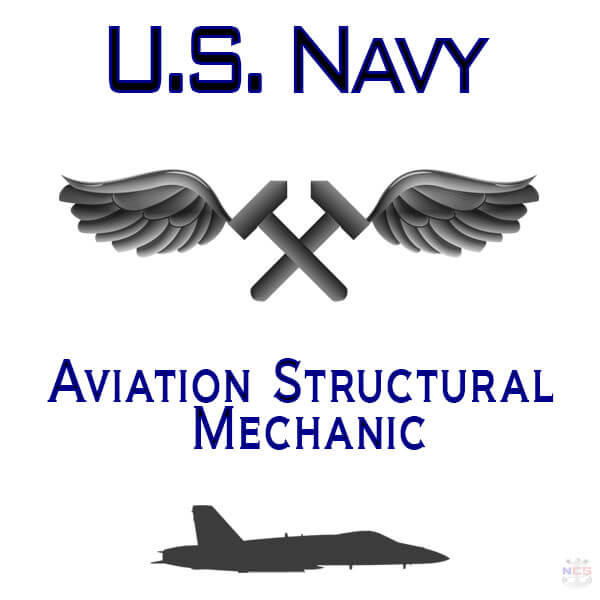The AM and AME Ratings

First known as the Aviation Metalsmith rating when it was established in 1921, it later evolved into the current Aviation Structural Mechanic (AM) rating in 1948. The rating branched into three main components, AMS(Structures), AMH(Hydraulics), and AME(Safety Equipment). On March 1, 2001, according to NAVADMIN 153/00, the AMS and AMH versions of the rating merged into the single, current AM rating. AME remains unchanged.
The Navy's computerized personnel system associates the rating name with an alphanumeric Navy Enlisted Manning Code (EMC). For AM, the EMC is A130; for AME, A131.
The Aviation Structural Mechanic (AM), maintains all aircraft main and auxiliary hydraulic power systems, actuating subsystems and landing gear. Responsible for maintenance on the aircraft fuselage (mainframe) wings airfoils, and associated fixed and movable surfaces and flight controls.
The Aviation Structural Mechanic - Safety Equipment (AME), maintains and repairs utility systems throughout the aircraft. They work on systems such as air conditioning, heating, pressurization and oxygen, plus multiple safety devices.
Aviation Structural Mechanic (AM) "A" school is approximately nine weeks long, and school is located in Pensacola, Florida. The AM rating requires a 48 month (4 year) service obligation for those leaving for boot-camp in Fiscal Year 2018 and beyond.
Aviation Structural Mechanic, Safety Equipment (AME) "A" school is approximately nine weeks long, and it is located in Pensacola, Florida. The AME rating requires a 60 month (5 year) service obligation.
Aviation Structural Mechanic job description (EMC A130)
Aviation Structural Mechanics remove, repair and replace hydraulic system pumps, auxiliary power systems and unit actuating subsystems. They maintain aircraft landing gear systems, brakes and related pneumatic systems, reservoir pressurization, emergency actuating devices, pumps, valves, regulators, cylinders, lines and fittings; service pressure accumulators, emergency air bottles, oleo struts, reservoirs and master brake cylinders, and inspect, remove and replace components of hydraulic systems.
AM's Replace gaskets, packing, and wipers in hydraulic components, and remove, repair and replace aircraft fuselage, wings, fixed and movable surfaces, airfoils, regular seats, wheels and tires, controls and mechanisms. They remove, install and rig aircraft flight control surfaces; fabricate and assemble metal components and make minor repairs to aircraft skin, and install rivets and metal fasteners and fabricate repairs for composite components. They are responsible for performing non-destructive dye penetrant inspections (NDI), and they perform daily, preflight, post-flight and other periodic aircraft inspections.
Aviation Structural Mechanic Safety Equipment job description (EMC A131)
The duties performed by AMEs include Maintain the various aircraft systems such as seat and canopy ejection (egress), gaseous and liquid oxygen, life raft ejection, fire extinguishing, air conditioning, cabin and cockpit heat, pressurization, ventilation. They remove and install oxygen system valves, gauges, converters and regulators, and inspect, remove, install and rig ejection seats, shoulder harnesses, lap belts and face-curtain mechanisms. AMEs also perform daily, preflight, post flight and other periodic aircraft inspections.
Career Sea - Shore Rotation Chart
| Rating | SEA1 | SEA2 | SEA3 | SEA4 | SEA/SH |
|---|---|---|---|---|---|
| AM | 54 | 48 | 42 | 36 | 36/36 |
| AME | 54 | 54 | 36 | 36 | |
| SH1 | SH2 | SH3 | SH4 | ||
| AM | 36 | 36 | 36 | 36 | |
| AME | 36 | 36 | 36 | 36 |
Sea tours and shore tours for Sailors that have completed four sea tours will be 36 months at sea followed by 36 ashore until retirement.
Qualifications, Interests, and Working Environment
Aviation Structural Mechanics require an orientation toward tools and equipment should possess manual dexterity and be physically fit. They must be able to keep records, have a knack for getting along well with other people and work as part of a team. The ability to do repetitive tasks and perform detailed work is also helpful.
Vision must correct to 20/20. Must have full field of vision. Must have normal depth perception and color perception. Members of this rate are not required to be citizens of the United States.
Aviation Structural Mechanics may be assigned to sea or shore duty any place in the world, so their working environment varies considerably. They may work in hangars or hangar decks, or outside on flight decks or flight lines at air stations. A high noise level is a normal part of their work environment. AM's work closely with others, do mostly physical work and require little supervision. AM's may also serve as flight engineers aboard certain aircraft. AM AME ASVAB Test requirements.
Approximately 8,000 men and women currently work in the AM rating, and about 1,600 men and women currently work in the AME rating.
Personnel in both Aviation Structural Mechanic ratings are paid allowances (BAH, BAS, etc. if eligible) and billet pay (sea pay, flight pay, etc. if eligible), and basic military pay based on years of service and paygrade.
Credit Recommendations
The American Council on Education recommends that semester hour credits be awarded in the vocational certificate or lower-division bachelor's/associate degree categories for airframe structure repair courses taken in these ratings.
Page written and maintained by NCCM Thomas Goering, USN (Retired).
If you are seeking information about joining the Navy, feel free to contact me.
